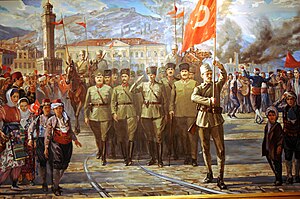
Back استرداد إزمير Arabic İzmirin qurtuluşu Azerbaijani ایزمیرین قورتولوشو AZB Einnahme von Izmir (1922) German Զմյուռնիայի գրավումը թուրքերի կողմից Armenian Perebutan Smyrna oleh Turki ID Conquista turca di Smirne Italian Inname van Smyrna Dutch İzmir'in Kurtuluşu Turkish
| Liberation of İzmir | |||||||||
|---|---|---|---|---|---|---|---|---|---|
| Part of the Greco-Turkish War (1919–22) | |||||||||
 Painting of the Turkish Army's entry into İzmir (located at Anıtkabir) | |||||||||
| |||||||||
| Belligerents | |||||||||
|
|
| ||||||||
| Commanders and leaders | |||||||||
|
Mustafa Kemal Pasha Fahrettin Pasha Mürsel Pasha Colonel Ahmet Zeki Colonel Mehmet Suphi[1] | Aristeidis Stergiadis | ||||||||
| Strength | |||||||||
|
1st Cavalry Division 2nd Cavalry Division 14th Cavalry Division Total: 9,100 – 9,200[2] | 40,000 (4 divisions)[3] | ||||||||
The Turkish retake of Izmir or the Liberation of İzmir (Turkish: İzmir'in Kurtuluşu) marked the end of the 1919–1922 Greco-Turkish War, and the culmination of the Turkish War of Independence. On 9 September 1922, following the headlong retreat of the Greek army after its defeat at the Battle of Dumlupınar and its evacuation from western Anatolia, the Turkish 5th Cavalry Corps under the command of Major-General Fahrettin Altay within Turkish Army under the command of Mustafa Kemal Pasha marched into the city of Smyrna (modern İzmir), bringing three years of Greek occupation to an end.[4]
- ^ Niş, Kemal; Söker, Reşat; Ercan, Tevfik; Anıt, Çetin (December 1995). Türk İstiklal Harbi II. Cilt Batı Cephesi 6. Kısım III. Kitap Büyük Taarruzda Takip Harekatı (31 Ağustos - 18 Eylül 1922) (in Turkish). Ankara, Türkiye: Genelkurmay Atase Başkanlığı Yayınları. p. 172. ISBN 9789754090598.
- ^ Niş, Kemal; Söker, Reşat; Ercan, Tevfik; Anıt, Çetin (December 1995). Türk İstiklal Harbi II. Cilt Batı Cephesi 6. Kısım III. Kitap Büyük Taarruzda Takip Harekatı (31 Ağustos - 18 Eylül 1922) (in Turkish). Ankara, Türkiye: Genelkurmay Atase Başkanlığı Yayınları. pp. 313–314. ISBN 9789754090598.
- ^ Greeks surrender Smyrna to Turks after shell fire, New York Times, published September 10, 1922.
- ^ Smith, Michael Llewellyn (1973). Ionian Vision: Greece in Asia Minor, 1919–1922. New York: St. Martin's Press. pp. 293–300.